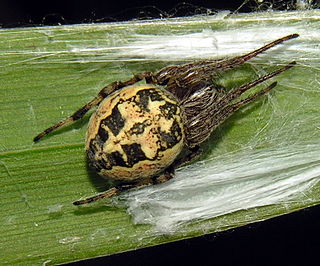
Scaffold web spiders (Nesticidae) is a family of araneomorph spiders closely allied with tangle web spiders. Like the "Theridiidae", these spiders have a comb of serrated bristles on the hind tarsi that are used to pull silk bands from the spinnerets. It contains 16 genera and about 300 species, many of which are associated with caves or overhangs. The genus Nesticus is the type for the family and is found throughout the world. The related Eidmannella has speciated considerably in Texas caves and includes some extremely localized species that are considered threatened. One species, Eidmannella pallida, is found in caves and under overhangs, but also in agricultural fields and other habitats away from such restricted areas. The genus Carpathonesticus is found in central Eurasia.

Larinioides is a genus of orb-weaver spiders first described by Lodovico di Caporiacco in 1934. They mostly occur in temperate climates around the northern hemisphere. The name is derived from the related araneid spider genus Larinia, with the meaning "like Larinia".
Zodarion bosmansi is a species of spider found in Portugal. Its colors are usually black or brown with orange-brown legs. Zodarion bosmansi Male has Pedipalp: tibial apophysis long, gently curved, terminally truncate. Prosoma and chelicerae light brown. Prosoma length: 2.03 mm. Legs yellow. Opisthosoma: dorsum sepia brown, venter pale. Body length of male: 4.08 mm and Zodarion bosmansi Female has Epigyne: median plate wider than long, anterior margin well marked with paired sclerotised lips. Colouration as in males. Prosoma length: 2.33 mm. Body length of female: 4.84 mm.
Troglohyphantes nigraerosae is a species of cave spider of the family Linyphiidae. It is endemic to Italy.
Ajmonia is a genus of cribellate araneomorph spiders in the family Dictynidae, and was first described by Lodovico di Caporiacco in 1934.

Salticus cingulatus is a Palearctic jumping spider of the family Salticidae.

Micaria pulicaria, the glossy ant spider, is a species of ground spider from the family Gnaphosidae with a Holarctic distribution.
Scorteccia is a monotypic genus of North African corinnid sac spiders containing the single species, Scorteccia termitarum. It was first described by Lodovico di Caporiacco in 1936, and has only been found in Libya.
Carpathonesticus is a genus of spiders in the family Nesticidae. It was first described in 1980 by Lehtinen & Saaristo. As of December 2019, it contains 21 species.
Carpathonesticus avrigensis is a species of araneomorph spider of the family Nesticidae. It occurs in Romania, where it was discovered in a cave. Only two specimens, a male and a female, are known.
Carpathonesticus lotriensis is an araneomorph spider species of the family Nesticidae. It occurs in Romania, where it can be found in caves.
Carpathonesticus racovitzai is an araneomorph spider species of the family Nesticidae. It occurs in Romania, where it can be found both in caves and outdoors. It was transferred from the genus Nesticus to Carpathonesticus in 1982 by Weiss and Heimer.
Carpathonesticus simoni is an araneomorph spider species of the family Nesticidae. It occurs in Romania, where it can be found in caves. It was transferred from the genus Nesticus to Carpathonesticus in 1980 by Lehtinen and Saaristo.
Carpathonesticus spelaeus is an araneomorph spider species of the family Nesticidae. It occurs in Romania, where it can be found in caves and outdoors under calcareous blocks. It was transferred from the genus Nesticus to Carpathonesticus in 1980 by Lehtinen and Saaristo.
Carpathonesticus zaitzevi is an araneomorph spider species of the family Nesticidae that occurs in Georgia. It was transferred from the genus Nesticus to Carpathonesticus in 1996.
Diminutella is a genus of spiders in the family Sparassidae. It was first described in 2018 by Rheims and Alayón. It is a monotypic genus with one described species, Diminutella cortina. It is endemic to Pinar del Rio, Cuba.

Ebrechtella tricuspidata is a species of crab spiders belonging to the family Thomisidae.
Domitius is a genus of European scaffold web spiders first described by C. Ribera in 2018.
Domitius beaticus is an araneomorph spider species of the family Nesticidae. It is known to occur in Spain. The species is troglobitic, occurring solely in caves.




